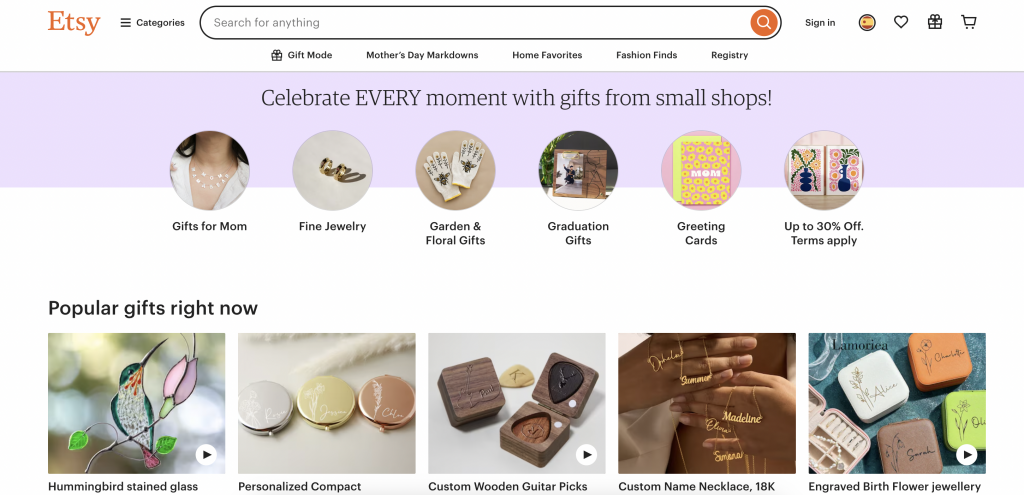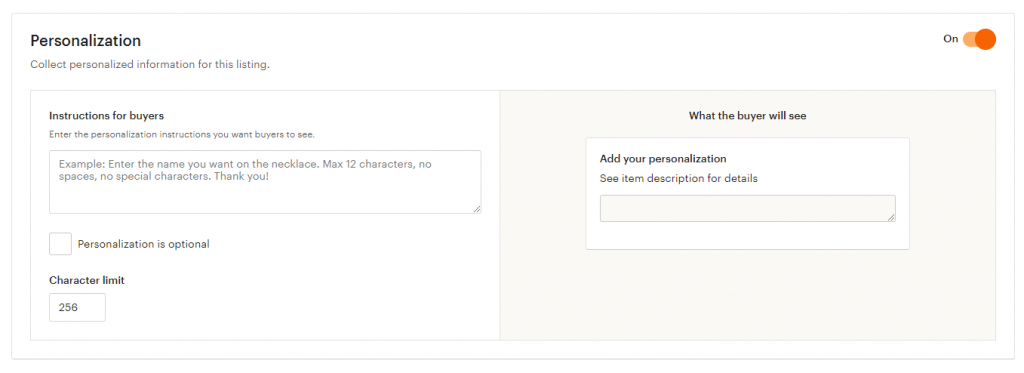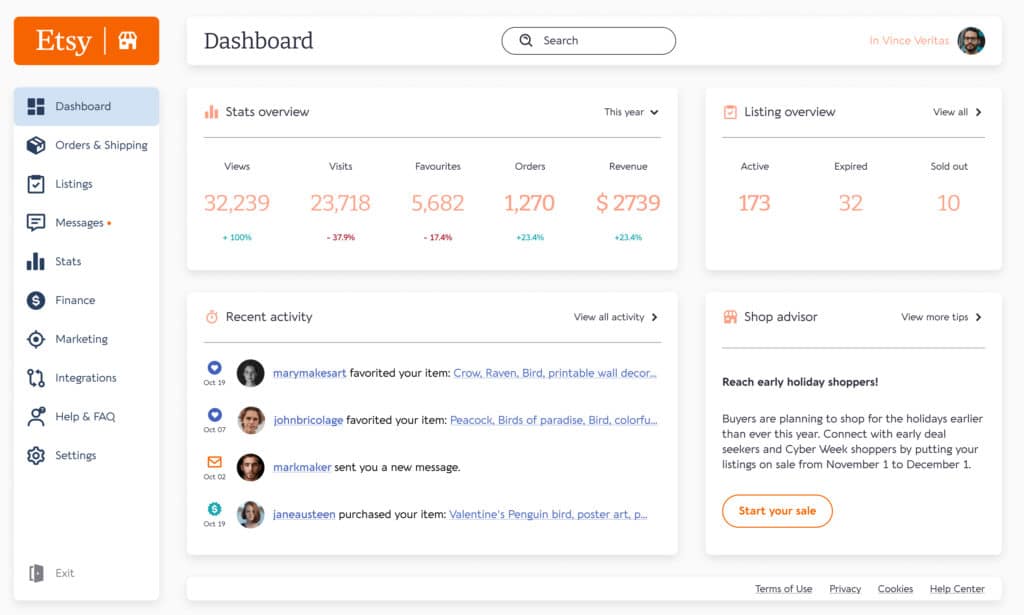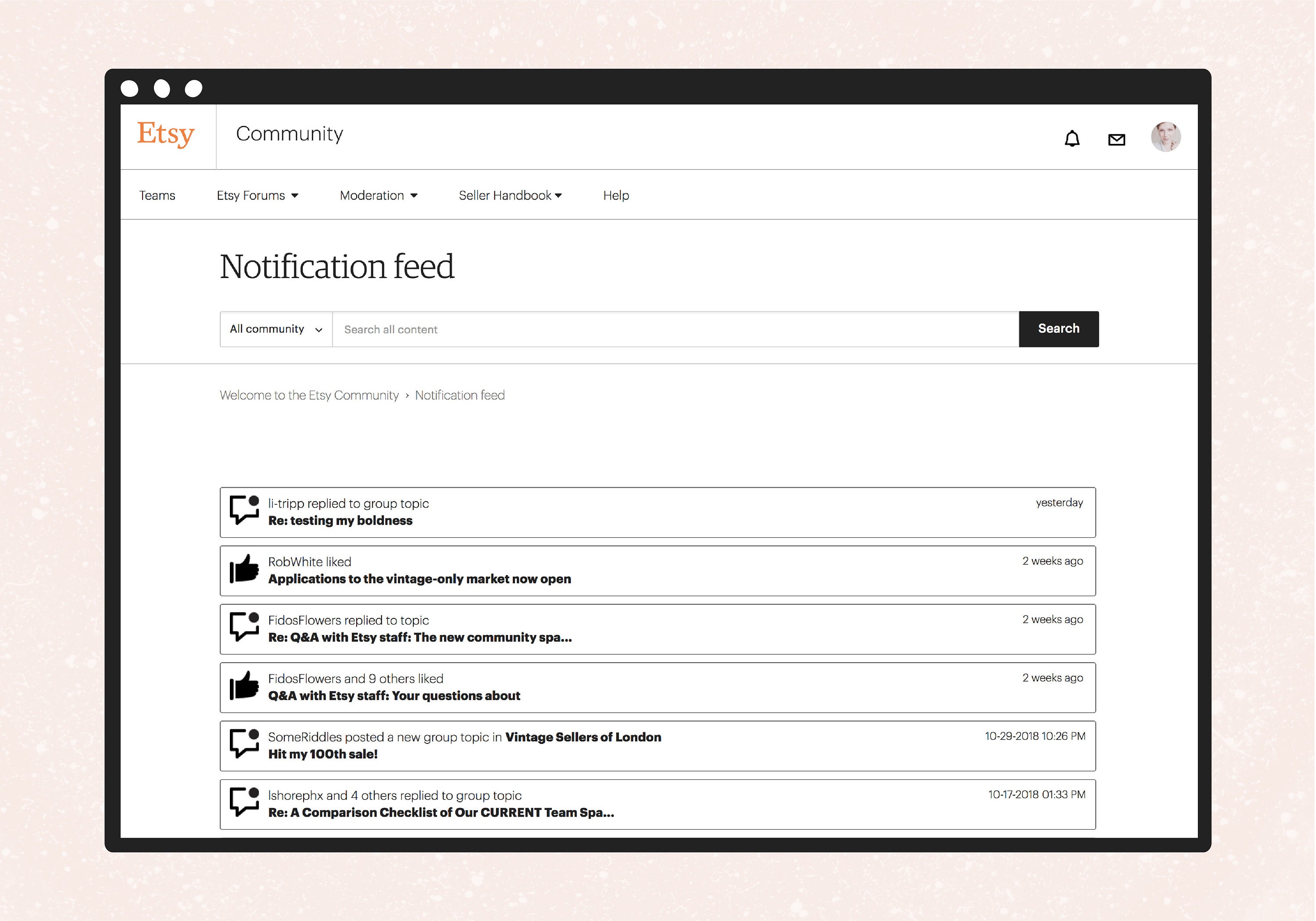blog»Business Strategy»Mastering Niche Markets: Etsy’s Strategic Blueprint for E-commerce Growth

Mastering Niche Markets: Etsy’s Strategic Blueprint for E-commerce Growth
2024/05/06
You can read this article in about 20 minutes
Introduction
In the ever-evolving landscape of e-commerce, few success stories are as compelling as that of Etsy, a platform that transformed the idea of niche markets into a colossal business model. Founded in 2005, Etsy began as a modest marketplace focused on handmade, vintage, and unique factory-made items. Today, it stands as a testament to the power of niche marketing, having grown into one of the largest e-commerce platforms in its domain. This growth trajectory provides a rich vein of insights for marketers aiming to carve out their own distinctive space in the crowded e-commerce arena.
The cornerstone of Etsy’s strategy was its unwavering commitment to a specific target audience—crafters, artists, and collectors. By focusing on this niche, Etsy managed to create a highly engaged community, a key factor in its expansive growth. The platform not only offered a marketplace but also fostered a sense of belonging among its users, which turned casual visitors into loyal customers and active participants.

For e-commerce marketers, Etsy’s approach offers valuable lessons on the effectiveness of understanding and optimizing for a niche market. The company’s ability to maintain its niche appeal while scaling up is particularly noteworthy. In this exploration, we will delve into the strategic maneuvers Etsy employed to engage its user base, enhance platform stickiness, and ultimately dominate its niche market. Through a detailed examination of Etsy’s methods, e-commerce professionals can glean actionable strategies to apply within their own market segments, ensuring sustained growth and success.
Section 1: Identifying the Niche
Etsy’s inception can be traced back to a simple yet revolutionary idea: to create a specialized marketplace for handmade and unique items, which were largely underserved by mainstream e-commerce platforms. The founders of Etsy recognized a gap in the market—small-scale artisans and vintage collectors needed a platform where they could thrive, distinct from the vast, all-encompassing world of mass-produced goods. This insight was pivotal to Etsy’s early strategy and laid the foundation for its distinct niche.

In the initial stages, Etsy faced the challenge of attracting both sellers and buyers to a new and untested platform. The approach was twofold: first, to build a community that valued craftsmanship and uniqueness over price and convenience; and second, to provide tools that empowered sellers to effectively showcase their products. By focusing on these aspects, Etsy was able to slowly cultivate a loyal user base.
Community building was another critical element in Etsy’s strategy. The platform was not just about buying and selling but also about fostering a sense of connection among like-minded individuals. Features such as forums, teams, and events encouraged interaction and engagement among users, which helped solidify Etsy’s identity as a community-centric platform. This focus on community engagement also made it more likely for users to return and participate more actively, thereby increasing the platform’s overall stickiness.
Etsy’s commitment to its niche has allowed it to stand out in a crowded e-commerce landscape. By steadfastly catering to artists, crafters, and collectors, Etsy created a unique space that resonated with specific consumer segments looking for something different from the typical retail experience. This clear vision and dedication to a niche market not only defined Etsy’s brand but also drove its growth, setting a benchmark for success in targeted marketing within e-commerce.
Section 2: Growth Strategies Employed by Etsy
As Etsy solidified its niche in the marketplace, the focus shifted towards scaling and growth. Central to this expansion were several key strategies that not only attracted a larger user base but also enhanced the overall user experience, crucial for maintaining the platform’s unique appeal.
1. Search Engine Optimization (SEO): Etsy understood early on that visibility in search results was critical for driving traffic to individual listings and the platform as a whole. The company invested in SEO to ensure that products listed on Etsy appeared prominently in search engine results, making it easier for potential customers to find unique items. This strategy was particularly effective because it capitalized on the growing trend of consumers searching for handmade and personalized items online. Learn more about SEO optimization
2. Content Marketing: Etsy leveraged content marketing by encouraging sellers to tell their stories, share the processes behind their crafts, and engage with the community through blog posts and social media. This not only enriched the content on the platform but also created an emotional connection with buyers, fostering loyalty and repeat business. Learn more about content optimization from Beats.
3. Enhancing Site Functionality: Recognizing the importance of a seamless user experience, Etsy continually optimized its website and mobile applications. Improvements in site navigation, payment processes, and the introduction of features like the ‘Etsy Picks’ curations, which highlighted unique items, made browsing and buying on Etsy a more enjoyable and convenient experience. Learn more about website optimization
Through these strategies, Etsy was able to maintain its niche appeal while scaling its operations. The focus on enhancing visibility through SEO, engaging users with compelling content, and improving the technical aspects of the platform ensured that Etsy remained attractive to both new and existing users. These growth tactics not only expanded Etsy’s market reach but also reinforced its position as a leader in the niche e-commerce sector.
Section 3: Engagement and Retention Techniques
Engagement and retention are pivotal for any e-commerce platform aiming to sustain growth, and Etsy’s approach to keeping users active and connected has been a model of success. Here’s how Etsy managed to enhance user engagement and ensure high retention rates among its community:
1. Personalized User Experiences: Etsy excels at creating personalized shopping experiences through tailored recommendations and curated content. By using data analytics to understand buying patterns and preferences, Etsy is able to present users with items that are more likely to pique their interest, thereby increasing the likelihood of purchases and repeat visits.

2. Seller and Buyer Tools: Etsy provides a suite of robust tools for sellers, including analytics dashboards, marketing tools, and support for managing their online stores. This empowers sellers with the knowledge and means to optimize their sales and fosters a proactive community of merchants. For buyers, Etsy simplifies the search and discovery process with features like favorites, follows, and notifications about new items from preferred shops, which helps keep the platform top of mind.

3. Community Engagement Initiatives: Etsy’s community forums and groups facilitate interaction among users who share similar interests. These forums serve as a place for advice, sharing success stories, and networking, which not only strengthens the community bonds but also encourages continuous engagement with the platform. Additionally, Etsy hosts events and workshops that further engage its user base by connecting them in real-world settings, thus enhancing their online interactions.

Through these methods, Etsy has not only maintained but also actively fostered a strong sense of community and loyalty among its users. By continuously improving user engagement and retention, Etsy has created a thriving ecosystem that supports sustained growth and a competitive edge in the niche market.
Section 4: Scaling the Platform
As Etsy grew, the platform faced significant challenges in scaling its operations while retaining its unique niche appeal. Etsy’s approach to managing growth involved several key strategies:
1. Maintaining Quality and Authenticity: As the number of sellers and listings increased, Etsy implemented stricter guidelines and quality controls to ensure that all products remained true to the platform’s core values of handmade and vintage uniqueness. This helped preserve the authenticity that attracted users to Etsy in the first place.
2. Technological Enhancements: To handle increased traffic and transactions, Etsy upgraded its technology infrastructure. This included enhancing server capacities and streamlining the payment processing system to handle higher volumes without compromising user experience.
3. Global Expansion: Etsy also looked to grow its user base internationally. The platform adapted its services to various markets by offering localized support and integrating regional payment methods, which allowed it to tap into new customer segments while staying true to its artistic and community-oriented ethos.
These efforts allowed Etsy to scale effectively, managing the delicate balance between growth and niche market appeal, thus securing its position as a leader in the global e-commerce landscape.
Section 5: Lessons for E-commerce Marketers
Etsy’s journey from a niche startup to a major player in the global e-commerce market offers valuable lessons for marketers aiming to replicate a similar level of success within their own niches. Here are some key takeaways that can be applied to any e-commerce venture:
1. Clearly Define Your Niche: Etsy’s success began with a clear focus on handmade and vintage items. By understanding and catering to the specific needs of artists, crafters, and collectors, Etsy was able to create a dedicated marketplace that stood out from broader e-commerce platforms. Marketers should strive to identify and clearly define their niche, understanding the unique needs and preferences of their target audience.
2. Foster a Strong Community: Etsy’s emphasis on community has been a major factor in its sustained growth. Creating a platform where users can interact, share, and participate in the broader community adds value beyond simple transactions. For e-commerce marketers, investing in building and nurturing a community can lead to greater customer loyalty and repeat business.
3. Invest in SEO and Content Marketing: Visibility is crucial in e-commerce. Etsy’s strategic use of SEO and content marketing helped it attract new users and keep them engaged. E-commerce marketers should focus on developing robust SEO strategies and creating compelling content that resonates with their target audience.
4. Optimize the User Experience: As Etsy grew, continuous improvements to site functionality made it easier for users to navigate and complete purchases. E-commerce platforms must prioritize user experience, ensuring that the site is intuitive, fast, and pleasant to use, which can significantly impact customer satisfaction and retention.
5. Balance Growth with Niche Appeal: As you scale, maintaining your niche appeal is crucial. Etsy managed to expand while still honoring its core values and quality standards. This balance is essential for e-commerce sites that want to grow without losing the unique characteristics that initially attracted their customer base.
By integrating these strategies, e-commerce marketers can not only attract but also retain a dedicated customer base, driving sustainable growth. Etsy’s model demonstrates the effectiveness of combining strategic marketing with a strong commitment to community and user experience, offering a blueprint that can be adapted across various market segments.
Conclusion
Etsy’s remarkable transformation from a niche marketplace to a leading global e-commerce platform underscores the power of strategic focus, community engagement, and customer-centric innovation. For e-commerce marketers, Etsy’s journey offers not just inspiration but practical strategies that can be adapted to their own businesses. By pinpointing a niche, fostering a strong community, and continuously enhancing user experience, marketers can create a thriving e-commerce environment that resonates with specific consumer segments. As we look to the future, the lessons from Etsy’s success story are clear: understanding and serving your niche market well is not just beneficial—it’s essential for sustainable growth and differentiation in a competitive landscape. Let Etsy’s blueprint guide your strategies, and you may well find your own path to e-commerce success.